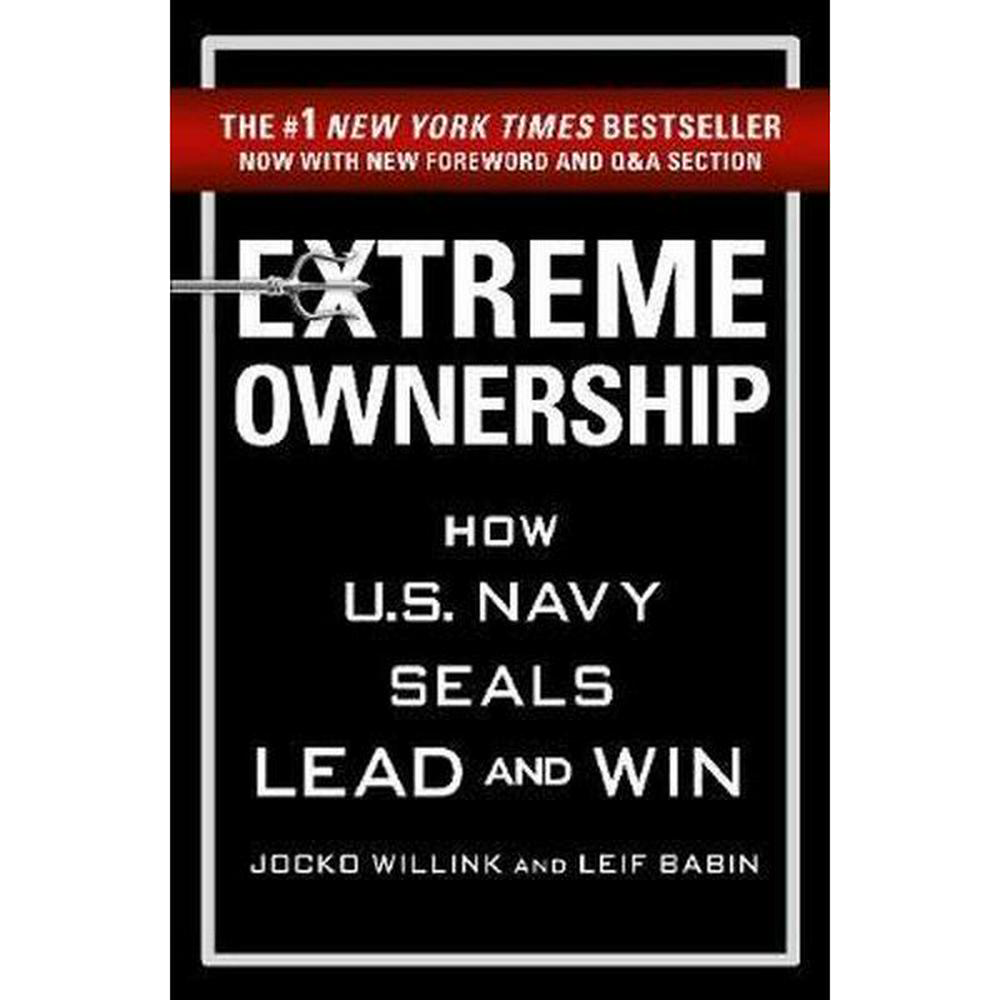I have been a big fan of Jocko Willink for awhile now listening to his podcast regularly and reading a couple of his books. I recently went back and re-read this book and took some notes. I read it again because my work situation has changed and I am now in more of a “leadership” position. This book is full of gold nuggets. Each Leadership lesson is laid out the principle of the lesson, how it applied to a real life situation on their deployment in Iraq, and how it applies to the business world.
There is lots of great advice and I have applied not only in my work life, but my personal and family life too.
Contents
Extreme Ownership:
Leaders must own everything in their world. There is no one else to blame
We often blame our own poor performance on bad luck, circumstances beyond our control, or poorly performing subordinates—anyone but ourselves, then attribute the success of others to luck. Total responsibility for failure is a difficult thing to accept, and taking ownership when things go wrong requires extraordinary humility and courage. But doing just that is an absolute necessity to learning, growing as a leader, and improving a team’s performance.
Good leaders don’t make excuses, instead they figure out a way to get it done and win.
The leader must acknowledge mistakes and admit failures, take ownership of them, and develop a plan to win.
There are no bad teams, just bad leaders. The leader must always strive to improve and they must instil that mindset in the team.
In order to convince and inspire others to follow and accomplish the mission, a leader must be a true believer in the mission. If you get a mission you don’t believe in, don’t sit back and accept it. Ask questions so you can understand why, then you can believe in what you are doing and pass that information down the chain of command. They can then execute the mission. The leader must explain not just what to do, but why.
For Leaders, the humility to admit and own mistakes and develop a plan to overcome them is essential to success. The best leaders are not driven by agenda or personal success. They are simply focused on the mission and how to accomplish it.
EGO
A leader must set ego aside, accept responsibility for failures, attack weaknesses, and consistently work to build a better and more effective team. Such a leader, however, does not take credit for his or her team’s successes but bestows that honour upon his subordinate leaders and team members. When a leader sets such an example and expects this from junior leaders within the team, the mind-set develops into the team’s culture at every level.
Ego clouds and disrupts everything:
- The planning process
- The ability to take good advice
- The ability to accept constructive criticism
Standards
As a Leader, it’s not what you preach, it’s what you tolerate. If substandard performance is accepted and no one is held accountable, that poor performance becomes the new standard. Therefore, leaders must enforce standards. Consequences for failing need not be immediately severe, but leaders must ensure that tasks are repeated until the higher expected standard is achieved. Leaders must push the standards in a way that encourages and enables the team to utilise Extreme Ownership.
If an individual on the team is not performing at the level required for the team to succeed, the leader must train and mentor the under performer. If they continue to fail to meet standards, the leader must be loyal to the team and terminate the under performer.
Cover & Move
This is essentially teamwork. All elements in the greater team are crucial and must work together to accomplish the mission, mutually supporting one another for that singular purpose.
Each member of the team is critical to success. If the overall team fails, everyone fails. Even if a specific member of the team did their job successfully.
Simple
Simplifying as much as possible is crucial to success. When plans are too complicated people may not understand them. And when things go wrong, complexity compounds the issues.
If your team doesn’t understand the plan, you have failed by not keeping it simple.
It is important that everyone has the chance to ask questions to clarify the mission.
Prioritise & Execute
Leaders must determine the highest priority task and execute.
The team must maintain the ability to reprioritise efforts as the landscape changes.
Try and stay ahead of problems using contingency plans. Try and anticipate problems that may arise
Decentralised Command
Humans are generally not capable of managing more than 6 – 10 people. Teams must be broken down into groups of 4 to 5 operators with a clearly designated leader. These leaders must understand the overall mission. They must understand not just what to do, but why they are doing it.
Junior leaders must fully understand what is in their decision making authority. They must communicate with Senior leaders to pass critical information. It is imperative that frontline leaders execute with confidence.
Plan
Planning begins with mission analysis. Leaders must identify clear directives for the team.
- Different courses of action must be explored and how best to accomplish them
- Leaders must delegate the planning process down the chain as much as possible to key subordinates
- Following a successful brief, all members will understand the strategic mission and their roles within the mission
- The best teams employ constant analysis of their tactics and measure their effectiveness so they can implement lesson learned for future missions
- Conduct a “post operational debrief” after each mission. What went right? What went wrong?
A true test for a good brief is not whether the senior officers are impresses, its whether or not the troops that are going to execute the operation actually understand it.
As a leader, if you are down in the weeds planning the details with your guys, you will have the same perspective as them which adds little value. If you allow them to plan the details it allows them to own their piece of the plan. And it allows you to stand back and see everything with a different perspective.
Leading up and down the chain of command
It is paramount that senior leaders explain to junior leaders and troops executing the mission how their role contributes to big picture success.
Leaders must routinely communicate with their team members to help them understand their role in the overall mission. They can then join the dots between what they do and how that impacts the company’s strategic goals.
If your team isn’t doing what you want them to do, you first have to look at yourself. Rather than blame them for not seeing the bigger picture, you must figure out a way to better communicate this to them.
Leading up the Chain of Command
Leadership doesn’t just flow down the chain of command, but up as well. Leaders have to own everything in their world.
If senior management have what seem to be stupid questions, it is our fault for not communicating the information they need.
If your boss isn’t making a decision in a timely manner or providing the necessary support, don’t blame the boss. Examine what you can do to better convey the critical information for the decisions to be made.
One of the most important jobs of any leader is to support your immediate leadership.
If the boss makes a decision that you may have argued against, you must execute that plan like it is your own.
Decisiveness and Uncertainty
It is critical for leaders to act decisively amid uncertainty, to make the best decisions they can based on the only information they have. There is no 100% right solution as the picture is never complete. Leaders must make decisions promptly and be ready to adjust based on evolving situations and new information.
Waiting for the 100% right solutions leads to delays and indecision.
The Dichotomy of Leadership
A Leader must lead, but also be ready to follow. Sometimes another team member might be in a better position to develop a plan, make a decision or lead through a specific situation. Perhaps a junior has greater expertise and more experience in a particular area. Or they have just thought of a better way to accomplish the mission.
A true leader is not intimidated when others step up and take charge. Leaders that lack confidence in themselves fear being outshined by someone else.
A good leader must be:
- Confident, but not cocky
- Courageous, but not foolhardy
- Competitive but a gracious loser
- Attentive to details but not obsessed by them
- Strong, but have endurance
- Quiet, but not silent
- Calm, but not robotic
- Logical, but not devoid of emotions
- Close with the troops, but not so close that one becomes more important than another, or more important than the good of the team, or they forget who is in charge
- Able to execute extreme ownership, while executing decentralised command

